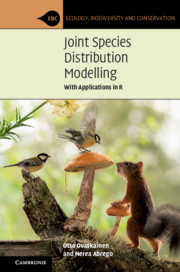Book contents
- Joint Species Distribution Modelling
- Ecology, Biodiversity and Conservation
- Joint Species Distribution Modelling
- Copyright page
- Contents
- Preface
- Acknowledgements
- Part I Introduction to Community Ecology
- Part II Building a Joint Species Distribution Model Step by Step
- Part III Applications and Perspectives
- 10 Linking HMSC Back to Community Assembly Processes
- 11 Illustration of HMSC Analyses
- 12 Conclusions and Future Directions
- Epilogue
- References
- Index
12 - Conclusions and Future Directions
from Part III - Applications and Perspectives
Published online by Cambridge University Press: 18 May 2020
- Joint Species Distribution Modelling
- Ecology, Biodiversity and Conservation
- Joint Species Distribution Modelling
- Copyright page
- Contents
- Preface
- Acknowledgements
- Part I Introduction to Community Ecology
- Part II Building a Joint Species Distribution Model Step by Step
- Part III Applications and Perspectives
- 10 Linking HMSC Back to Community Assembly Processes
- 11 Illustration of HMSC Analyses
- 12 Conclusions and Future Directions
- Epilogue
- References
- Index
Summary
This concluding chapter discusses the strengths and limitations of Hierarchical Modelling of Species Communities (HMSC) in light of the results presented in this book. Concerning the strengths, the chapter notes that HMSC is a unifying framework that encompasses classic approaches such as single-species distribution models and model-based ordinations as special cases, which hence provides simultaneous inferences at the species and community levels. As another key strength, the chapter notes that HMSC can be applied to many kinds of study designs (including hierarchical, temporal or spatial) and many types of data (such as presence–absence, counts and continuous measurements). The chapter further emphasises that HMSC offers the general advantages of model-based approaches, such as tools for model validation and prediction, and that it is especially well suited for predictive modelling of communities with sparse data. Concerning the limitations, the chapter discusses three areas where future development is needed: a broader set of data models, a broader array of model structures related to various ecological and evolutionary processes, and improved computational efficiency.
Keywords
Information
- Type
- Chapter
- Information
- Joint Species Distribution ModellingWith Applications in R, pp. 337 - 346Publisher: Cambridge University PressPrint publication year: 2020
